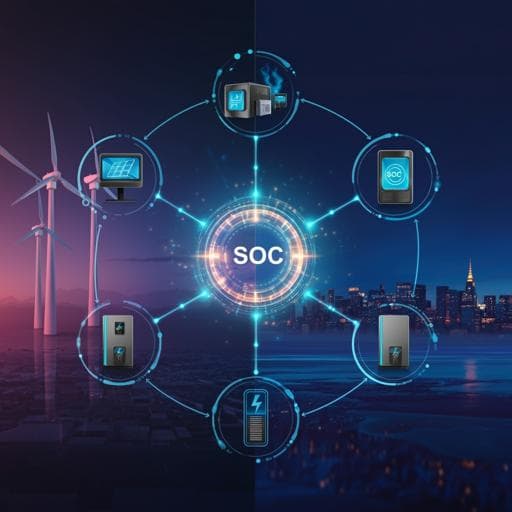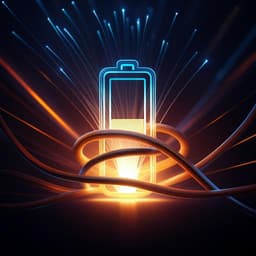
Engineering and Technology
Reversible Power-to-Gas systems for energy conversion and storage
G. Glenk and S. Reichelstein
Explore how Power-to-Gas processes can revolutionize energy systems by converting excess electricity into hydrogen. This research by Gunther Glenk and Stefan Reichelstein reveals that integrated systems are already cost-competitive in Texas and will remain viable as hydrogen prices fluctuate.
~3 min • Beginner • English
Introduction
Large-scale deployment of intermittent renewables increases the challenge of balancing electricity supply and demand in real time. Beyond batteries, electrolytic hydrogen production (Power-to-Gas, PtG) can absorb surplus electricity to produce hydrogen, and reversible PtG can also convert hydrogen back to electricity in scarcity periods, thereby linking hydrogen and electricity markets and potentially dampening electricity price volatility. Reversible PtG can be implemented modularly (separate electrolyzer and fuel cell/gas turbine) or in an integrated unitized regenerative fuel cell (URFC), such as solid oxide cell (SOC) or PEM-based technology. Prior work suggests electrolyzers are becoming cost-competitive for hydrogen production, whereas fuel cells and gas turbines have been viewed as too expensive for grid electricity generation from hydrogen. This paper asks under what conditions reversible PtG—modular or integrated—becomes economically viable, quantifies the value of reversibility, and evaluates current and prospective viability in Germany and Texas where renewable penetration and price volatility differ.
Literature Review
The study builds on research documenting the growing role of hydrogen in decarbonization and the increasing volatility of electricity markets with higher renewable penetration. Prior analyses find electrolyzers increasingly cost-competitive for hydrogen production, while one-directional fuel cells and gas turbines are typically uneconomic for selling electricity back to wholesale markets. Unitized regenerative fuel cells (SOC, PEM) have emerged that can operate bidirectionally on the same equipment with fast ramping once at temperature. Literature reports near-constant PEM electrolyzer efficiency beyond a low utilization threshold, and system-level SOC conversion rates are reported at full capacity. Earlier work has not established detailed functional forms for efficiency versus capacity factor, implying uncertainty about part-load behavior. Studies of storage economics highlight the importance of price volatility and round-trip efficiency. The authors’ prior work (Glenk & Reichelstein) on electrolyzer economics and vertical integration is extended here to reversible systems, including levelized cost methods and market-based viability thresholds.
Methodology
Model scope and systems: The authors model reversible PtG systems that either (i) produce hydrogen from electricity via electrolysis (PtG) or (ii) produce electricity from hydrogen (GtP). Two architectures are considered: (a) modular systems with separate one-directional electrolyzer and fuel cell or gas turbine; (b) integrated unitized regenerative fuel cells (URFC), particularly solid oxide cell (SOC) or PEM-based, capable of operating in one direction at a time on shared equipment.
Markets and time: The system is a price-taker in hourly wholesale electricity markets with price q(t) over t ∈ [0, 8760] hours per year. Hydrogen sells or is procured at a time-invariant market price p per kg, reflecting typical contracting practice. The annual distribution of electricity prices is assumed stationary over the asset lifetime (base case). Capacity factors CF_t ∈ [0,1] are chosen continuously to optimize operations. Start-up heating from cold and its energy/time costs are considered in a supplementary extension; under conservative assumptions, heating costs have minor impact because optimal operations entail few heat-up cycles annually.
Operations and contribution margins (modular): For PtG (hydrogen production), the conversion rate is denoted η_H(CF_t) in kg per kWh; written in the paper as CF_t for brevity at full utilization. Variable cost equals electricity price q(t) plus a per-kWh increment w (water, consumables, markups). The contribution margin per kWh at time t is CM_H(CF_t,t|p) = ([η_H(CF_t)·p] − q(t) − w) · CF_t. For GtP (electricity generation), revenue is q(t); hydrogen input cost p is scaled by the electricity conversion rate η_E(CF_t) (kWh per kg) and an incremental cost w. The per-kWh margin is CM_E(CF_t,t|p) = (q(t) − η_E(CF_t)·p − w) · CF_t. Thermodynamic limits imply η_H(CF_t^H)·η_E(CF_t^E) ≤ 1, so at most one of the two per-kWh operating margins is positive at any time; efficiently, CF_t^H·CF_t^E = 0 and the system chooses the direction with positive margin or idles. Aggregating optimized margins over the year yields CM^P(p) for PtG and CM^G(p) for GtP.
Operations and contribution margins (integrated): The integrated URFC shares equipment and imposes the technical constraint CF_t^H·CF_t^E = 0. Incremental costs may differ between directions (w_i^H, w_i^E), as may conversion rates (η_i). The per-kWh margins are CM_H(CF_t^H,t|p) = ([η_i,H(CF_t^H)·p] − q(t) − w_i^H)·CF_t^H and CM_E(CF_t^E,t|p) = (q(t) − η_i,E(CF_t^E)·p − w_i^E)·CF_t^E. Optimizing hour by hour and integrating over the year yields the aggregate optimized contribution margin CM_i(p). The optimized CM_i(p) is convex and U-shaped in p due to separability and linearity in p within each direction; thus there are at most two break-even hydrogen prices where CM_i(p) equals levelized fixed cost (LFC).
Cost-competitiveness and value of reversibility: Levelized fixed cost (LFC) converts acquisition cost and fixed O&M (including tax effects, depreciation shields, and cost of capital) into a per-kWh fixed cost using a levelization factor L that discounts available operating hours over the asset life, accounting for capacity degradation. For modular subsystems, LFC^P (electrolyzer) and LFC^G (GtP) are compared to CM^P(p) and CM^G(p), respectively. Break-even hydrogen prices p1 and p2 satisfy CM^P(p1)=LFC^P and CM^G(p2)=LFC^G. Finding 1: the modular reversible system is cost-competitive if either subsystem is NPV-positive; reversibility is valuable only if both are NPV-positive, i.e., p ∈ [p1, p2] with p1 < p2. For the integrated system, cost-competitiveness requires CM_i(p) ≥ LFC, yielding up to two break-even prices p_l and p_u around the minimum of CM_i(p) at p*. Reversibility is valuable if the optimal policy uses both directions in some hours at the prevailing p, which occurs for p in ranges where both hydrogen production and electricity generation are occasionally profitable given price volatility and round-trip efficiency.
Calibration and data: The model is calibrated to Germany and Texas using 2019 day-ahead wholesale electricity prices, reflecting similar averages but higher volatility in Texas. System parameters (prices, conversion rates, lifetimes) are drawn from literature, industry data, and reports. Modular system: one-directional PEM electrolyzer (system price, conversion rate 0.019 kg/kWh) and combined-cycle gas turbine (system price, 20 kWh/kg). Integrated system: unitized regenerative SOC (system price, conversion rate to hydrogen 0.023 kg/kWh, to electricity 20 kWh/kg). Useful lifetimes: modular 25 years; integrated 15 years. Costs of capital: Germany 4%, Texas 6%. Taxes and levelization follow standard LCOE-style accounting. Electricity procurement assumptions reflect exemptions in Germany for electrolysis and wholesale access with markups in Texas. Hydrogen benchmark prices by market segment: large-scale 1.5–2.5 €/kg, medium-scale 3.0–4.0 €/kg, small-scale >4.0 €/kg.
Prospective analysis: SOC cost trajectory estimated from N=79 price observations (2000–2019) via constant elasticity regression v(i)=v(0)·β^i; annual decline 8.95% (95% CI ±3.20%). Expected efficiency improvements to 2030: SOC to 0.024 kg/kWh (hydrogen) and 21.67 kWh/kg (electricity); PEM electrolyzer conversion rate to 0.023 kg/kWh; modular gas turbine parameters unchanged. Future projections hold the distribution of electricity prices constant to isolate technology trends.
Key Findings
- Finding 1 (modular): The modular reversible PtG system is cost-competitive if at the prevailing hydrogen price p either the PtG electrolyzer or the GtP subsystem has positive NPV; reversibility is valuable only if both are NPV-positive, i.e., p in [p1, p2]. In current markets p1 < p2 does not hold, so reversibility is not valuable for modular systems.
- Finding 2 (integrated): The integrated reversible PtG system is cost-competitive if p lies outside a middle range around the minimum of CM_i(p); reversibility is valuable when the system operates in both directions for some hours at the prevailing p, which depends on round-trip efficiency and electricity price volatility.
- Current economics (2019 calibration):
• Germany (modular): Break-even hydrogen price for PtG electrolyzer p_G = 3.18 €/kg; for GtP p_P = 0.57 €/kg. Electrolyzer can be competitive at medium/small-scale hydrogen prices; GtP not competitive; reversibility not valuable (p_P < p_G).
• Texas (modular): p_G = 2.98 $/kg; p_P = 1.31 $/kg. Electrolyzer competitive; GtP not; reversibility not valuable. Higher p_P in Texas reflects much higher price volatility (prices >$0.15/kWh occur regularly).
• Germany (integrated SOC): Break-evens: lower p_P = 0.03 €/kg, upper p_G = 3.38 €/kg. Critical prices: lower p_l = −1.81 €/kg, upper p_u = 2.43 €/kg. Cost-competitive for medium and small-scale hydrogen prices; reversibility valuable near and above 2.43 €/kg as system mostly produces hydrogen but occasionally generates electricity.
• Texas (integrated SOC): Break-evens: lower p_P = −0.09 $/kg, upper p_G = 2.78 $/kg. Critical prices: lower p_l = 0.59 $/kg; upper p_u > 5.0 $/kg. Cost-competitive at hydrogen prices ≥$2.78/kg (borderline for large-scale); reversibility already valuable for medium-scale prices within (2.78, 5.0+ $/kg). Integrated system’s break-even ($2.78/kg) is lower than modular electrolyzer ($2.98/kg), despite higher system price, due to higher utilization and flexibility.
- Prospects to 2030:
• SOC system prices projected to decline ~8.95%/yr; conversion efficiencies to improve (to ~0.024 kg/kWh and 21.67 kWh/kg). PEM electrolyzer efficiency to ~0.023 kg/kWh; gas turbine unchanged.
• Modular electrolyzers become cost-competitive even for large-scale hydrogen prices by mid-decade (earlier in Texas), but modular GtP remains uneconomic; the gap between p_G and p_P narrows yet does not make modular reversibility valuable.
• Integrated systems become widely cost-competitive for large-scale hydrogen in both jurisdictions. The value of reversibility increases; in Texas, the no-go middle range [p_l, p_u] nearly closes by decade’s end, implying CM_i(p) > LFC across a broad p range. In Germany, reversibility becomes valuable in the latter half of the decade as the system more often shifts to power generation during price peaks.
Discussion
The research question—when and where are reversible PtG systems economically viable, and what is the value of reversibility—is addressed by an operational and financial model that optimizes hourly operations against observed electricity price distributions and compares optimized contribution margins to levelized fixed costs. The findings show that modular reversibility offers little economic value under current and projected conditions because one-directional GtP remains uneconomic, even as electrolyzers improve. In contrast, integrated SOC-based systems are already cost-competitive in settings with pronounced electricity price volatility (Texas) at current medium-scale hydrogen prices, and reversibility is valuable because selective electricity generation during scarcity hours materially raises annual margins. In Germany, integrated systems are competitive at medium/small-scale hydrogen prices and are projected to gain reversibility value as technology improves. These results imply that integrated reversible PtG can serve as both a hydrogen supply source and an effective buffer against intermittency, dampening price spikes by delivering electricity during scarce hours and absorbing surplus power to produce hydrogen. Flexibility confers robustness to lower hydrogen prices over time, as operations shift endogenously toward electricity generation when profitable.
Conclusion
The paper develops a comprehensive techno-economic model for reversible PtG systems and applies it to Germany and Texas. It demonstrates that: (i) modular reversibility is not currently valuable and is unlikely to become so this decade because GtP remains uneconomic; (ii) integrated SOC-based reversible PtG is already cost-competitive at current hydrogen prices in high-volatility markets like Texas and competitive for medium/small-scale prices in Germany; and (iii) ongoing declines in SOC costs and efficiency gains will expand cost-competitiveness and increase the value of reversibility, potentially making integrated systems viable across a wide range of hydrogen prices by 2030. Future research directions include: evaluating vertical integration with renewable generation to increase utilization; benchmarking against alternative long-duration storage technologies (batteries, pumped hydro); and modeling endogenous learning-by-deployment to capture policy-relevant dynamic cost reductions.
Limitations
- Electricity price distribution is assumed stationary over the asset lifetime; structural changes in market design or penetration of renewables could alter volatility and averages.
- Base model assumes near-instant transition to operating temperature without efficiency loss; although an extension includes heating time/energy and frequency, estimates may vary with specific designs and duty cycles.
- Conversion efficiencies for integrated systems are taken at or near full utilization; the shape of efficiency versus capacity factor is not well established, which could affect optimized operations and margins.
- Hydrogen price p is modeled as time-invariant; in practice, contract terms and market dynamics may introduce variability and basis risk.
- Projections hold electricity price distributions constant to isolate technology trends; evolving price levels and volatility (likely favorable) are not explicitly modeled.
- Cost decline projections for SOCs use a univariate time-based regression; learning-by-deployment and scale effects are not explicitly modeled, potentially biasing forecasts.
- Results rely on day-ahead markets; real-time market participation (analyzed in supplementary note) may change outcomes depending on intra-day volatility and operational constraints.
- Site-specific costs (e.g., interconnection, hydrogen transport/storage, taxes/fees) are simplified via markups and may differ in practice.
Related Publications
Explore these studies to deepen your understanding of the subject.







